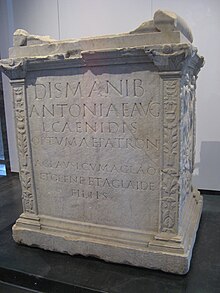| Roman imperial dynasties | ||
|---|---|---|
| Flavian dynasty | ||
| Chronology | ||
| Vespasian 69–79 AD | ||
| Titus 79–81 AD | ||
| Domitian 81–96 AD | ||
| Family | ||
|
||
Antonia Caenis, (died 75 AD) a former slave and secretary of Antonia Minor (mother of the emperor Claudius), was Roman emperor Vespasian's contubernalis.
Life
It could be thought that she had family in Istria, now in Croatia, based on a trip she took there (Suet. Dom. 12.3). In her 30s Caenis, still possibly a slave, was in an unofficial type of relationship with Vespasian, known as contubernium, before his marriage. According to Suetonius, after the death of Vespasian's wife Flavia Domitilla, Vespasian and Caenis, now a freedwoman, resumed their relationship; she was his wife "in all but name" until her death in AD 75.
According to Cassius Dio, she had a remarkable memory and considerable influence on the emperor's administration, carried out official business on his behalf, and apparently made a lot of money from her position. However, Suetonius states that she was treated with disrespect by Vespasian's son Domitian, who refused to greet her as one of the family.
Popular culture

The life of Caenis and her love-story with Vespasian are portrayed in Lindsey Davis's novel The Course of Honour. She is also a character who features regularly in Robert Fabbri's Vespasian series, in which she is depicted as a long-lost grand-niece of the king of the Caenii, a rebelling tribe in Thracia.
Robert Graves, in his short story "Caenis on Incest", used her as a kind of foil to present what he then thought to have been the underlying reason for the power-related murders chronicled in I, Claudius. The story is included in his compendium "Occupation: Writer", and he admits to having missed the real reason for the murders in the introduction to that anthology.
See also
References
- "Companion: Caenis". feminaeromanae.org. Retrieved 2019-11-22.
- Anagnostou-Laoutides, Eva; Charles, M.B. (2012). "Vespasian, Caenis and Suetonius". In Deroux, C. (ed.). Studies in Latin Literature and Roman History XVI. Brussels: Editions Latomus. pp. 530–547.
- Acton, Karen (2010-05-12). "Antonia Caenis and the Flavian Dynasty". SSRN Electronic Journal. doi:10.2139/ssrn.1605506.
- Lefkowitz, Mary R.; Fant, Maureen B. (2005-08-23). Women's Life in Greece and Rome: A Source Book in Translation. JHU Press. ISBN 978-0-8018-8310-1.
- "LacusCurtius • Roman Law — Contubernium (Smith's Dictionary, 1875)".
- (Cassius Dio 66.14)
- (Suet. Dom. 12.3)
- CIL 6.12037
- "Caenis on Incest A.D. 75 (1946)" from "Occupation: Writer" Universal Library, Grosset and Dunlap, 1950
Sources
- Suetonius, Lives of the Twelve Caesars: Vespasian 3, 21; Domitian 12.3
- Dio Cassius, Roman History 66.14
- William Smith (1870), Dictionary of Greek and Roman Biography and Mythology